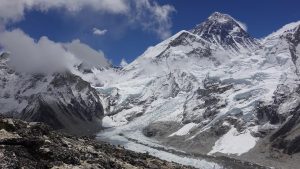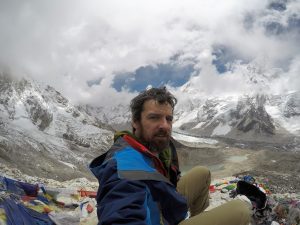Waiting on Mt. Everest Basecamp: Patience & Perseverance
If you’ve read a few expedition mountaineering books, you’ll learn that waiting in base camp for good weather is a part of expedition life. After you’ve read a dozen expedition books, sitting out bad weather in a tent almost seems like a mandatory right of passage for expeditionary climbers.
But, reading about discomfort and actually experiencing it yourself are very different. It’s like the difference between reading about a dental visit and actually sitting in that padded chair as the dentist sticks a sharp pick into your mouth – it’s a lot more unpleasant when you’re the one actually going through it!
And so it is worth waiting for clear weather on Mount Everest. In fact, rest days spent in base camp are not very tough. We sleep late, have a slow breakfast at 8 am, then putter around our tents reading and writing until lunch time. Maybe we take a nap after lunch, do a few hours of gear and personal care, then it’s time for dinner and an early movie before heading off to bed around 9 pm. The excellent cooking staff takes care of all the meals and kitchen cleaning, so it really isn’t rough at all.
Our primary job is to rest, recover, and do some moderate hikes to maintain fitness and altitude acclimatization. In fact, we are supposed to eat and drink as much as possible to minimize weight loss. Sounds like a sweet and lazy deal, doesn’t it? Then why on earth does it seem so terribly difficult to wait for clear weather at Everest Base Camp?
HIGH HOPES
Most climbers at Mount Everest have been planning and dreaming of climbing this mountain for years, or even decades. In my case, I have been thinking about coming here for 40 years. I’ve been actively working toward this climb for more than 30 years.
To get here we train the hardest we ever have. We all took two months off from work, tried to minimize the impact on our families, and spent a lot of time and money to get here. In short, we have a lot riding on the outcome. After all of that our hopes are quite high. We’d like to summit in good weather and get to go home early. But sometimes, that’s not how it goes.
While the 2017 Everest season started out smooth and fast, things have changed. Both the wind and snow are taking turns on the south side of Everest breaking the schedule into small, tough to utilize chunks of acceptable weather. The weather models are struggling to account for all this choppy variability. So while, we are all hoping for a fast, smooth finish to this two-month long journey, that is not what’s happening.
LOW SPIRITS
When an uncontrollable variable like the weather forces you to just sit and wait, it can be tough. The first few days are fine – we enjoy the down time and rest. But, once the waiting starts to exceed what you were mentally prepared for, the forced delay can start grinding on you. Mental attitudes start to decline. Small things start bugging you: the chilly ice under your tent seems annoyingly colder. The food seems boring. People can get a bit edgy. Spirits start to sink lower.
That is when we have to lift each other up. Crack jokes, take hikes together, cheer each other up. Remind each other that we can endure the wait and get through this.
We also have to trust the proven process and our highly experienced Sherpa guides, western guides, and team leaders. As experienced climbers, we all know that rushing toward the top under an enthusiastic wave of “summit fever” is undisciplined, risky, and unacceptable. We must accept the conditions around us, adapt to them, and act with careful intention.
Perhaps the most difficult part for action-oriented Everest climbers is that while waiting for better weather, our natural instincts to push hard and get the job done are wrong and counter-productive. What we need to do is to corral those desires, and instead find a way to stay calm and inactive. It takes control and discipline to put those action-driving desires aside, and instead do what you know is right – sit and wait.
This slow-moving period its definitively not about persevering forward in spite of adverse conditions. The main trait needed now is patience.
PATIENCE IS PASSIVE PERSEVERANCE
Patience has never been my strong suit. It’s perhaps been my biggest challenge of this long, long trip. And that is what makes sitting in base camp so darn difficult.
Yesterday was Day 55 of this Everest expedition, and Day 9 of waiting in base camp. Lying in my tent, I slowly sipped a protein-rich recovery drink while staring at the yellow nylon ceiling. My mind struggled with the two major concepts before me – patience and perseverance. How could I persevere, when all I could do was sit and be patient?
Then it hit me: Patience is passive perseverance.
When you need to be active, then perseverance is about action, moving, and pushing forward for progress, no matter how difficult.
But during necessary periods of inaction, then patience is actually the core of perseverance. When there is no beneficial action to take, then by default being calm and patient is the way to persevere through. Patience is passive perseverance.
A LESSON FROM BRUCE LEE
Before I got into mountaineering, I focused my physical energies on martial arts. During our freshman year at UMass. Amherst, my good friend Chris Flood introduced me to Tae Kwon Do. We practiced a great deal together under our instructor, Danny Chang. Chris also introduced me to martial arts movies, including those of the great master, Bruce Lee. Although some movies were silly, his masterpiece film, “Enter the Dragon”, is quite good and is still a favorite movie of mine today, even though my martial art days are long gone.
In that movie, Bruce has bravely defeated dozens of bad guys and overcome long odds, but then finds himself trapped in an inescapable hall of mirrors. At first, Bruce tries to bash his way out with a mad flurry of kicks and punches to the mirrors, but he soon realizes that fighting against these prison walls is useless. Then Bruce does an amazing thing. He ceases his activity and sits on the floor cross-legged. His chest is running with sweat from his vigorous efforts, but he slows his breathing. Then he takes his nun-chucks, his weapon, and hangs them calmly around his neck. He closes his eyes, focuses, and relaxes.
Bruce had definitely not quit or given into despair. He was being patient until conditions improved when he could once again apply his considerable skill and perseverance to fight his way out. Until things got better, Bruce knew that the smart move was to rest, recover and conserve strength for the next round ahead.
And that is precisely what we need to do here at Everest Base Camp.
When conditions improve, it will be time to engage our active perseverance by packing, climbing, and pushing hard for the top. But, while we wait, patience is passive perseverance.
When action is needed, then active perseverance makes us resilient.
When patience is needed, then passive perseverance keeps us resilient.
And if we can stay resilient long enough, then sometime soon we might get to touch the top of the world.


